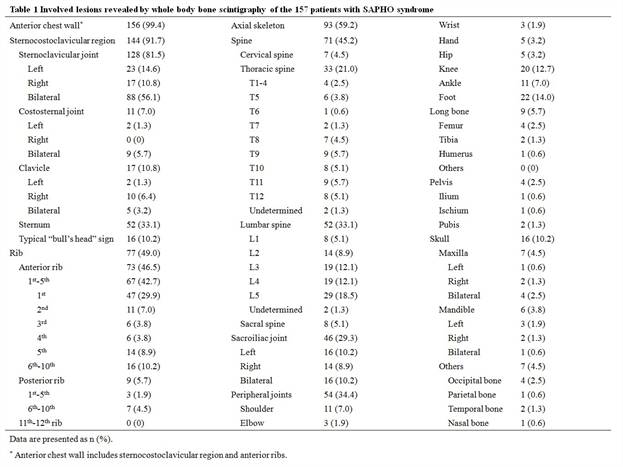Session Information
Session Type: ACR Concurrent Abstract Session
Session Time: 4:30PM-6:00PM
Background/Purpose: The aim was to explore patterns of osteoarticular involvement in SAPHO syndrome using cluster analysis of lesions revealed by whole body bone scintigraphy.
Methods: Data on whole body bone scintigraphy was collected in 157 patients enrolled in a single center cohort study1 who fulfill the Kahn and Khan’s criteria for SAPHO syndrome2. Twelve characteristic or most frequently involved osteoarticular sites in SAPHO syndrome revealed by whole body bone scintigraphy were analyzed by hierarchical cluster analysis with the Ward minimum-variance method.
Results: Three major subtypes with distinct patterns of osteoarticular involvement were identified: (A) the sternoclavicular type (52 patients), with predominant involvement of bilateral sternoclavicular joints, characterized by the classic “bull’s head” sign; (B) the costal type (35 patients), with predominant lesions in the anterior ribs, particularly the first ribs; and (C) the spinal type (70 patients), with significantly higher frequency of lesions in the thoracic, lumbar and sacral spine. Interestingly, a significant increase in age at onset of skin lesions was observed in spinal type (40.1 ± 11.2 years) than sternoclavicular type (34.6 ± 10.5 years, p = 0.036) and costal type (35.0 ± 10.0 years, p = 0.035). On the other hand, the duration of disease was significantly higher in sternoclavicular type (93.2 ± 120.4 months) compared with costal type (27.6 ± 32.2 months, p = 0.001) and spinal type (29.0 ± 37.1 months, p < 0.001).
Conclusion: The osteoarticular involvement in SAPHO syndrome can be clustered into three distinct patterns with different clinical pictures. The costal involvement in SAPHO syndrome, which was less well recognized previously, may define a separate type of the disease.
REFERENCES
1. Li, C., Zuo, Y., Wu, N., Li, L., Li, F., & Zhang, W., et al. (2016). Synovitis, acne, pustulosis, hyperostosis and osteitis syndrome: a single centre study of a cohort of 164 patients. Rheumatology, 55(6), 1023.
2. Kahn, M. F., & Khan, M. A. (1994). The SAPHO syndrome. Baillieres Clinical Rheumatology, 8(2), 333.
To cite this abstract in AMA style:
Cao Y, Li C, Xu P, Li Y, Yang Q, Sun X. Patterns of Osteoarticular Involvement in SAPHO Syndrome: A Cluster Analysis Based on Whole Body Bone Scintigraphy in 157 Patients [abstract]. Arthritis Rheumatol. 2017; 69 (suppl 10). https://acrabstracts.org/abstract/patterns-of-osteoarticular-involvement-in-sapho-syndrome-a-cluster-analysis-based-on-whole-body-bone-scintigraphy-in-157-patients/. Accessed .« Back to 2017 ACR/ARHP Annual Meeting
ACR Meeting Abstracts - https://acrabstracts.org/abstract/patterns-of-osteoarticular-involvement-in-sapho-syndrome-a-cluster-analysis-based-on-whole-body-bone-scintigraphy-in-157-patients/



